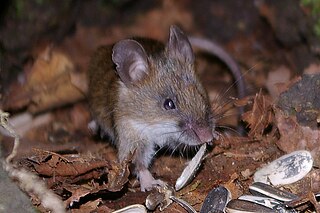
The grey butcherbird is a widely distributed species endemic to Australia. It occurs in a range of different habitats including arid, semi-arid and temperate zones. It is found across southern Australia, but is absent from the deserts of central Australia and the monsoon tropics of northern Australia. It has a characteristic "rollicking" birdsong. It appears to be adapting well to city living, and can be encountered in the suburbs of many Australian cities including Brisbane, Melbourne, and Sydney. The grey butcherbird preys on small vertebrates including other birds.

Monodactylus argenteus is a species of fish in the family Monodactylidae, the moonyfishes. Its common names include silver moonyfish, or silver moony, butter bream, and diamondfish. It is native to the western Pacific and Indian Oceans, including the Persian Gulf, Red Sea, and associated estuaries, such as the Mekong Delta.

The small Japanese field mouse is a species of rodent in the family Muridae. It is found only in Japan.
Pappobolus is a genus of flowering plant in the sunflower family native to the Andes Mountains of Colombia, Ecuador, and Peru.
Pappobolus ecuadoriensis is a species of flowering plant in the family Asteraceae. It is found only in Ecuador. Its natural habitat is subtropical or tropical dry shrubland. It is threatened by habitat loss.
Pappobolus hypargyreus is a species of flowering plant in the family Asteraceae. It is found only in Ecuador. Its natural habitat is subtropical or tropical dry shrubland. It is threatened by habitat loss.
Pappobolus juncosae is a species of flowering plant in the family Asteraceae. It is found only in Ecuador. Its natural habitat is subtropical or tropical dry shrubland. It is threatened by habitat loss.
Pappobolus lehmannii is a species of flowering plant in the family Asteraceae. It is found only in Ecuador. Its natural habitat is subtropical or tropical dry shrubland. It is threatened by habitat loss.
Pappobolus nigrescens is a species of flowering plant in the family Asteraceae. It is found only in Ecuador. Its natural habitat is subtropical or tropical moist montane forests. It is threatened by habitat loss.
Pappobolus sanchezii is a species of flowering plant in the family Asteraceae. It is found only in Peru.

Leptopelis argenteus, also known as the silvery tree frog or triad tree frog, is a species of frog in the family Arthroleptidae. It is found in coastal Kenya and Tanzania and south to northern Mozambique, southern Malawi, and eastern highlands of Zimbabwe.

Leptopelis broadleyi is a species of frog in the family Arthroleptidae of uncertain status. The Amphibian Species of the World, the IUCN SSC Amphibian Specialist Group, and the African Amphibians do not recognize it, but instead consider it synonym with Leptopelis argenteus. However, the AmphibiaWeb recognizes it as a valid species.

Mantidactylus argenteus is a species of frog in the family Mantellidae. It is endemic to Madagascar. Its natural habitats are subtropical or tropical moist lowland forests and heavily degraded former forest. It is threatened by habitat loss.

The Japanese dormouse is a species of rodent in the family Gliridae endemic to Japan. It is the only extant species within the genus Glirulus. Its natural habitat is temperate forests. In Japanese, it is called yamane. Among dormice, it has the special ability of running at great speed upside down, suspended from branches. Its main food is insects, berries, nectar, or pollen. It tends to inhabit arboreal nesting sites to avoid interspecific competition with the small Japanese field mouse because of their sympatric relationship.
Diplotaxodon argenteus is a species of fish in the family Cichlidae. It is found in Malawi, Mozambique, and Tanzania. Its natural habitat is freshwater lakes.
Lethrinops argenteus is a species of cichlid endemic to Lake Malawi. This species grows to a length of 19 centimetres (7.5 in) TL.

The silver-backed butcherbird is a small, shrike-like bird. It is almost identical to the grey butcherbird of which it considered by some authorities to be a subspecies, C. torquatus argenteus.
Rosefin barb is a species of cyprinid fish in the genus Enteromius from rivers in Angola and Namibia.
The southern groove toothed moss-mouse is a species of rodent in the family Muridae found in Southern Papua New Guinea. As opposed to M. richardsoni, argenteus sp can be differentiated most prominently by its gray-brown pelage.
Neoniphon argenteus, the clearfin squirrelfish or silver squirrelfish, is a seldom-seen member of the family Holocentridae. It is native to the Indian Ocean and Pacific Ocean from East Africa to New Caledonia. It is also found both north and south of Australia and throughout Micronesia. It lives mainly around islands and shallow reefs, and like N. sammara is associated with Acropora corals. Its depth range is 3–20 m (9.8–65.6 ft) and it can reach sizes of up to 24.0 cm (9.4 in) TL. It feeds primarily on benthic invertebrates. It is found in the ornamental trade and can be used as bait in tuna fisheries, but there are currently no known major threats to the species.







